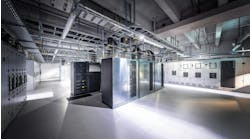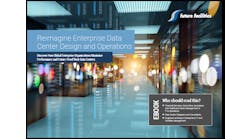In this week’s Voices of the Industry, Chris Sharp, CTO, Digital Realty, explores how leveraging the power of software-defined SDN can help you build next-generation networks and ramp up your hybrid cloud strategy.
Chris Sharp, CTO, Digital Realty
One of the biggest key differentiators between industry leaders and followers is speed. Whether it’s speed of innovation, adaptation to new technology or business factors, or just having the fastest performing product – nobody wins by performing worse than their competition. This is increasingly true with business and consumer services.
Poor website and app performance are business killers. Ensuring network performance is becoming as important as securing it, driving CIOs, CTOs and VPs of IT to continually search for new ways to stretch the capabilities of their existing IT infrastructure—without a need for major capital investment.
Many businesses are migrating to hybrid cloud solutions to gain scaling and agility while still maintaining security and control. Eighty-five percent of enterprises are using a hybrid cloud strategy, running 41% of workloads in public clouds and 38% in private clouds, based on Rightscale research.
A successful hybrid cloud infrastructure enables on-demand access to virtual hardware, software and a variety of critical IT services. Ultimately, it instantly expands your digital capabilities by giving you the ability to scale out to cloud environments, access the newest technology and services on demand, and adjust IT resources up or down as needed. Hybrid infrastructure can also increase your speed to market by allowing you to quickly and easily set up test environments to prototype or launch new products within minutes.
Bottom line, hybrid gives you greater security, flexibility, control and easy access to future technology.
That’s the good news. Unfortunately, legacy networking has not evolved quickly enough to keep up with the pace of the cloud evolution, and hybrid cloud is only as fast as the network between the hosted environments and cloud environments. So, the forward-looking enterprises are going beyond just deploying hybrid cloud infrastructure, and adopting fundamental network virtualization technologies such as software defined networking (SDN) to enable next-generation network capabilities that can keep up with major changes in demand, latency and participant endpoints, configured in near-real-time, to ramp-up their cloud computing architecture even more.
[clickToTweet tweet=”Chris Sharp – A successful hybrid cloud infrastructure enables on-demand access to virtual hardware, software and a variety of critical IT services. #datacenters” quote=”Chris Sharp – A successful hybrid cloud infrastructure enables on-demand access to virtual hardware, software and a variety of critical IT services. #datacenters”]
The general catchphrase for SDN is, “It does for networking what virtualization did for computing.” What SDN means in practice is that much of the difficult, manual, and often error-prone process of establishing complex network topologies among multiple participants can be automated, virtualized, and compartmentalized. Automation is already the base principle of large cloud compute environments, and that capability is essential to running a nimble IT environment – meeting the growing demand for network speed, increased bandwidth and deploying new services in real time.
Why Data Center Automation is Key to Ramping Up Your Network
The business productivity that results from using SDN technologies fundamentally disrupts legacy network models of “negotiate a contract, buy a fixed amount of bandwidth to a fixed destination for a number of years, and wait for it to be installed” and helps you to more quickly and easily establish an “interconnection model” that can support high-performance computing. When the traditional data center functions of network, compute, storage, content delivery, disaster recovery and more are available at a click, the data center itself has become a solution center.
Using SDN, data centers can instantly deliver a variety of services and benefits to its customers and partners, including:
- Increased agility, flexibility and cost savings: By leveraging SDN, automated data centers can offer enterprises a smorgasbord of service providers to select from and engage with based on customer preference. If a customer’s needs change, or monitoring reveals that performance has been impacted, the customer simply selects and switches to a new service within SLA parameters. This dynamic virtual datacenter network lets IT teams avoid the disruptions of service that impact business, and establish regionally discrete backup or DR solutions from their web browser.
- The ability to scale up or down automatically and eliminate vendor lockdown: “Cloud bursting” is useful for companies with big seasonal, batch, or event-driven variations in their compute, storage and networking needs. SDN enables an interface where customers with volatile resource needs can access a marketplace of services that offer real-time performance data on those services. Using the automated interface, customers select a new service that meets their specific performance and capacity requirements, have the interface build out, initiate the service, and set up billing within minutes – then turn those services down when no longer needed, without penalty.
- Savings on space and power: A reduced need for dedicated networking hardware frees up space in the data center and reduces specialized training, maintenance contracts, and consultancy costs. This change is a boon for any enterprise looking to add functionality without having to deploy and support special equipment, or find and contract with specialized engineering support.
SDN-Based Service Exchanges Delivers Powerful Benefits
Leveraging the power of SDN, Digital Realty Service Exchange, powered by Megaport, extends the power of your hybrid cloud architecture by:
- Improving access between your private and public clouds, your hybrid deployment, making it easier to move workloads as needed
- Lowering latency, up to 35%, between your two environments, and increasing the throughput by twice the file-write speeds
- Improving application performance by up to 55%
- Giving you private access to top three clouds within 8 markets, along with access to all availability zones across the globe
Chris Sharp is CTO at Digital Realty.
Learn more about how the Digital Realty Service Exchange, leveraging the power of software-defined SDN, can help you build next-generation networks and ramp up your hybrid cloud strategy.






